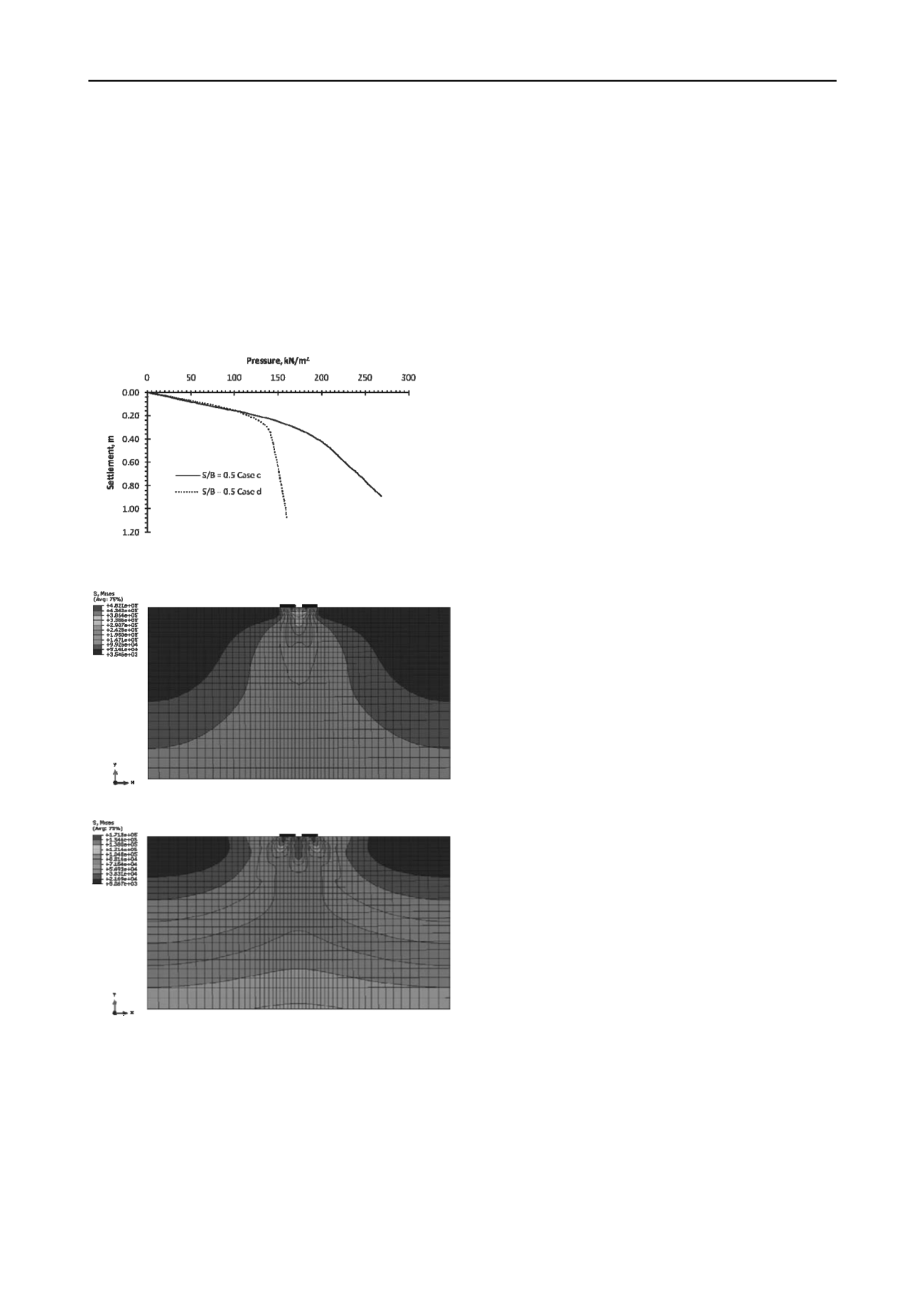
3462
Proceedings of the 18
th
International Conference on Soil Mechanics and Geotechnical Engineering, Paris 2013
settlement of the footings as compared to the isolated footing is
found. Similar observation is made for case d wherein the stress
isobars diverge or are in opposite direction hence negligible or
no overlap of stress contours is seen in the vicinity of footing
edges where the stress concentration will be high and at greater
depths of footings the stress contours overlap a bit. Henceforth,
it is observed that the interference phenomenon has no
significant effect on the bearing capacity; however it has certain
considerable effect on the settlement of the footings. It is also
observed that at the node point 1 m below the axis of symmetry,
the vertical settlement obtained for case c is higher than that
obtained for case d since in case c the footing loads on left and
right footings converge towards the axis of symmetry and vice
versa in case d.
Figure 9. Pressure settlement curves of case c and case d at S/B
equal to 0.5.
Figure 10. Stress contour for case c at S/B equal to 0.5.
Figure 11. Stress contour for case d at S/B equal to 0.5.
4
CONCLUSIONS
A limited study is presented on the effect of two closely spaced
rigid strip footings resting on the surface of homogeneous soil
subjected to inclined load. The effect of interference
phenomenon on ultimate bearing capacity and settlement at
working load condition are studied. The phenomenon has
certain considerable effect on the ultimate bearing capacity,
increasing its capacity when footings are vertically loaded. For
the cases where footings are subjected to inclined load the effect
of interference on the bearing capacity has no significant effect.
However for all the cases of inclined loading condition, the
interference effect on the settlement is quite significant. The
settlement of interfering footings in the range of working load
decreases with increase in the clear spacing between the
footings and attains a value as that of isolated footing at greater
clear spacing (S ≥ 5B).
5
REFERENCES
Terzaghi K. 1943.
Theoretical soil mechanics
. John Wiley and Sons,
New York.
Meyerhof G.G. 1963. Some recent research on the bearing capacity of
foundations.
Canadian Geotechnical J.
1 (1), 16-26.
Vesic A.S. 1973. Analysis of ultimate loads of shallow foundations.
J.
Soil Mech. and Found. Div.
99 (1), 45-73.
Stuart J.G. 1962. Interference between foundations with special
reference to surface footings in sand.
Geotechnique J.
12 (1), 15-
23.
Graham J. Raymond G.P. and Suppiah A. 1984. Bearing capacity of
three closely-spaced footings on sand.
Geotechnique J.
34 (2), 173-
182.
Kumar J. and Ghosh P. 2007. Ultimate bearing capacity of two
interfering rough strip footings.
Int. J. Geomech
. 7 (1), 53-61.
Kumar J. and Kouzer K.M. 2007. Bearing capacity of two interfering
footings.
Int. J. Num. Analyt. Methods in Geomech
. 32, 251-264.
Kumar J. and Bhattacharya P. 2010. Bearing capacity of interfering
multiple strip footings by using lower bound finite elements limit
analysis.
Computers and Geotechnics
37, 731-736.
Mabrouki A. Benmeddour D. Frank R. and Mellas M. 2010. Numerical
study of the bearing capacity for two interfering strip footings on
sands.
Computers and Geotechnics
37(4), 431-439.
Kouzer K.M. and Kumar J. 2010. Ultimate bearing capacity of a footing
considering the interference of an existing footing on sand.
Geotech. Geol. Eng
. 28 (4), 457-470.
Ghosh P. and Sharma A. 2010. Interference effect of two nearby strip
footings on layered soil: theory of elasticity approach.
Acta
geotechnica
5, 189-198.
Nainegali L. and Basudhar P.K. 2011. Interference of two closely
spaced footings: A finite element modeling.
ASCE Geotechnical
Special Publiactions, Geo-forntiers: Advances in Geotechnical
Engineering
, Dallas, Tx.
Lee J. Eun J. Prezzi M. and Salgado R. 2008. Strain influence diagrams
for settlement estimation of both isolated and multiple footings in
sand.
J. Geotech. Geoenviron. Eng
. 134 (4), 417-427.
Nainegali L.S. Basudhar P.K. and Ghosh P. 2012. Analysis of nearby
rigid strip footingson elastic soil bed subjected to inclined load.
Indian Geotechnical Conference: Advances in Geotechnical
Engineering
NewDelhi, India.
Khing K.H. Das B.M. Yen S.C. Puri V.K. and Cook E.E. 1992.
Interference effect of two closely spaced shallow strip foundations
on geogrid reinforced sand.
Geotech Geolog Eng
. 10, 257-271.
Das B.M. Puri V.K. and Neo B.K. 1993. Interference effects between
two surface footings on layered soil.
Transportation Research
Record
1406, 34-40.
Kumar A. and Saran S. 2003. Closely Spaced Footings on Geogrid-
Reinforced Sand.
J. Geotech. Geoenviron. Eng
. 129 (7), 660-664.
Kumar J. and Bhoi M.K. 2009. Interference of two closely spaced strip
footings on sand using model tests.
J. Geotech. Geoenviron. Eng
.
135 (4), 595-604.
Ghosh P. Kumar P. 2009. Interference effect of two nearby strip
footings on reinforced sand.
Contemporary Eng Sciences
2 (12),
577-592.
Ghosh. P. Magistris. F. and Fabbrocino. G. 2011. Seismic response of
pier foundations of an existing roadway bridge. 5th International
Conference on Earthquake Geotechnical Engineering (5ICEGE)
Santiago, Chile.
ABAQUS User’s Manual. 2010. ABAQUS/Standard user’s manual,
volume II version 6.10. Hibbitt Karlsson and Sorenson Inc. Rhode
Island.
Potts D.M. and Zdravkovic, L. 1999.
Finite element analysis in
geotechnical engineering
. 1, 2, Thomas Telford Publications,
London.


